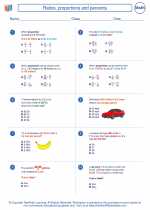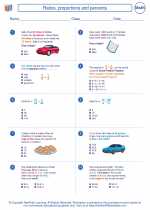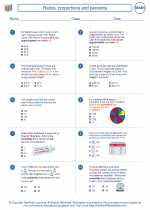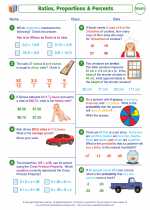Ratios, Proportions, and Percents
Ratios
A ratio is a comparison of two numbers. It can be written in three ways: using the word "to," using a colon, or as a fraction. For example, the ratio of boys to girls in a class of 20 students can be written as 4:6, 4 to 6, or 4/6.
Proportions
A proportion is an equation that states that two ratios are equal. For example, if 2/3 is equal to 4/x, then it forms a proportion. Proportions can be solved using cross multiplication.
Percents
A percent is a ratio that compares a number to 100. It is often represented using the symbol "%". For example, 25% means 25 out of 100, or 0.25 as a decimal. Percentages are commonly used to express parts of a whole or to compare one quantity to another.
Study Guide
- Understand the concept of ratios and how to express them in different forms.
- Learn how to identify and solve proportions by using cross multiplication.
- Practice converting between fractions, decimals, and percents.
- Understand the relationship between fractions, decimals, and percents.
- Apply the concepts of ratios, proportions, and percents to real-world problems, such as discounts, taxes, and interest rates.
Example Problems
1. Calculate 30% of 80.
Answer: To calculate 30% of 80, you can use the formula: (30/100) * 80 = 24.
2. Solve the proportion: 2/5 = 4/x.
Answer: Cross multiplying gives you 2x = 20, so x = 10.
3. Express the ratio 3:5 as a fraction in simplest form.
Answer: The ratio 3:5 can be written as the fraction 3/5, which is already in its simplest form.
. Create and Print your own Math Worksheetswith Math Worksheet Generator
◂Math Worksheets and Study Guides Eighth Grade. Ratios, proportions and percents

 Worksheet/Answer key
Worksheet/Answer key
 Worksheet/Answer key
Worksheet/Answer key
 Worksheet/Answer key
Worksheet/Answer key
 Worksheet/Answer key
Worksheet/Answer key
